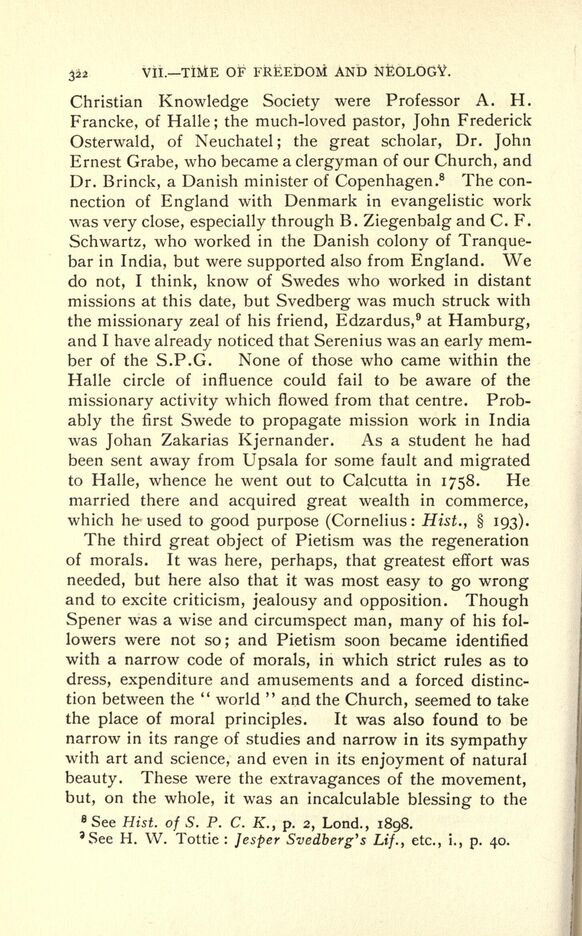
Full resolution (JPEG) - On this page / på denna sida - VII. The Church in the “Time of Freedom” and Period of Neology (1718—1811 A.D.)

<< prev. page << föreg. sida << >> nästa sida >> next page >>
Below is the raw OCR text
from the above scanned image.
Do you see an error? Proofread the page now!
Här nedan syns maskintolkade texten från faksimilbilden ovan.
Ser du något fel? Korrekturläs sidan nu!
This page has never been proofread. / Denna sida har aldrig korrekturlästs.
322 VII. TIME OF FREEDOM AND NEOLOGY.
Christian Knowledge Society were Professor A. H.
Francke, of Halle ;
the much-loved pastor, John Frederick
Osterwald, of Neuchatel; the great scholar, Dr. John
Ernest Grabe, who became a clergyman of our Church, and
Dr. Brinck, a Danish minister of Copenhagen.
8
The con
nection of England with Denmark in evangelistic work
was very close, especially through B. Ziegenbalg and C. F.
Schwartz, who worked in the Danish colony of Tranque-
bar in India, but were supported also from England. We
do not, I think, know of Swedes who worked in distant
missions at this date, but Svedberg was much struck with
the missionary zeal of his friend, Edzardus,
9
at Hamburg,
and I have already noticed that Serenius was an early mem
ber of the S.P.G. None of those who came within the
Halle circle of influence could fail to be aware of the
missionary activity which flowed from that centre. Prob
ably the first Swede to propagate mission work in India
was Johan Zakarias Kjernander. As a student he had
been sent away from Upsala for some fault and migrated
to Halle, whence he went out to Calcutta in 1758. He
married there and acquired great wealth in commerce,
which he used to good purpose (Cornelius: Hist., 193).
The third great object of Pietism was the regeneration
of morals. It was here, perhaps, that greatest effort was
needed, but here also that it was most easy to go wrong
and to excite criticism, jealousy and opposition. Though
Spener was a wise and circumspect man, many of his fol
lowers were not so; and Pietism soon became identified
with a narrow code of morals, in which strict rules as to
dress, expenditure and amusements and a forced distinc
tion between the
"
world
"
and the Church, seemed to take
the place of moral principles. It was also found to be
narrow in its range of studies and narrow in its sympathy
with art and science, and even in its enjoyment of natural
beauty. These were the extravagances of the movement,
but, on the whole, it was an incalculable blessing to the
8
See Hist, of S. P. C. K., p. 2, Lond., 1898.
5
See H. W. Tottie :
Jesper Svedberg s Lif., etc., i., p. 40.
<< prev. page << föreg. sida << >> nästa sida >> next page >>